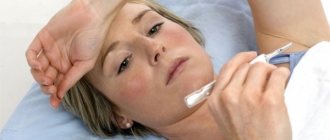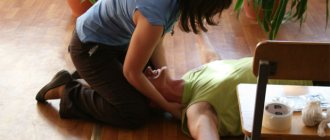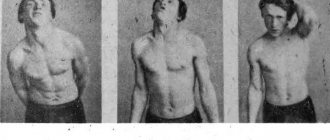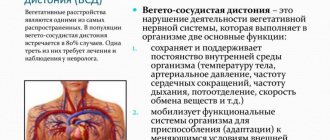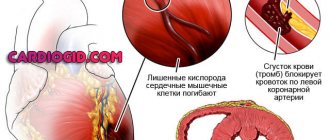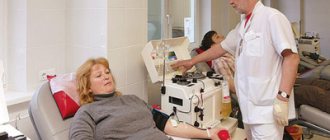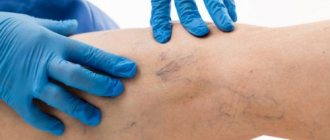0
Author of the article: Marina Dmitrievna
2017.10.22
325
Vessels
Signs of autonomic disorders in men are similar to those in women, but men are less likely to seek medical help. Sometimes a man may not know that he is developing a disorder. Doctors do not call VSD a disease, since it is a syndrome, or functional disorder, of the autonomic nervous system (ANS). It is the ANS that is responsible for nervous regulation in the body. When there is a failure in the system, it entails changes in the functioning of the heart, stomach, respiratory system, kidneys, etc.
Panic
VSD is rarely diagnosed in men, since they are less receptive and emotional than women. The fair sex loves to work themselves up and formulate in their psyche a full-fledged fear of a new attack of VSD.
Treatment of VSD repeats the therapy for women. The main thing is to normalize the state of the ANS. When nervous regulation between organs is normal, then negative symptoms will no longer make themselves felt.
A little history
The symptoms of VSD in men were first described by military doctor Jacob de Costa during the American Civil War. He noticed that young, apparently healthy soldiers suddenly began to experience attacks of dizziness, palpitations and weakness.
A little later, the same symptoms were described in the English army, but, nevertheless, today the International Classification of Diseases (ICD) does not consider VSD a disease. It is rather a syndrome that is characterized by a certain state of the cardiovascular and autonomic nervous system. What happens then?
Symptoms of VSD in men
Autonomic dysfunction of the male ANS leads to a number of changes that can manifest themselves either individually or in combination. The main symptoms in men are:
- Fatigue quickly.
- Headache.
- Dizziness.
- Feeling of spots and spots before the eyes.
- Noise in ears.
- Lack of stability in the legs.
- Weakness in the limbs.
- Coldness in the legs and arms.
- Lack of appetite.
- Nausea.
- Bloating, constipation, diarrhea.
- Cardiopalmus.
- Feeling of a lump in the throat.
- Increased sweating.
- Drowsiness.
- Slight increase in temperature.
- Lack of concentration.
- High irritability.
- Bad memory.
- Decreased sexual desire.
- Feeling of fear, panic.
These symptoms of VSD manifest themselves in different ways. Sometimes they can appear with greater or less intensity. They manifest themselves especially clearly against the background of experienced stress. Often combined. For example: along with shortness of breath, a person may experience arrhythmia and excessive sweating.
The essence of vegetative-vascular dystonia
The human nervous system is divided into two parts. One of them, relatively speaking, looks, tastes, listens and is responsible for motor functions. The second part that a person practically does not encounter is the autonomic nervous system. It is divided into two sections:
- sympathetic NS;
- parasympathetic nervous system.
These systems regulate those functions that are certainly needed in the human body, but a person knows nothing about them. For example, how is the speed at which the heart should contract, or how large should the lumen of the bronchi be? All this happens as if by itself, but in fact, the regulation of these functions is carried out by the autonomic nervous system.
A failure in this system is called vegetative-vascular dystonia. In men, it can manifest itself with various symptoms, depending on the type of syndrome, including sexual dysfunction.
What treatment is prescribed?
Physical exercise
With a sharp change in climate zone, traveling by plane, or due to changes in weather conditions, an exacerbation of VSD often occurs.
Sport occupies a leading place in the treatment of VSD. An active lifestyle helps restore blood circulation and vascular tone, helps relieve tension, and eliminates the symptoms of dystonia. It is recommended to do morning exercises daily and take walks in the fresh air. Swimming and any water-related sports are beneficial. You should reduce the time you spend in front of the computer or TV.
Restoring psycho-emotional balance
Hypnosis sessions will help the patient get rid of subconscious negative attitudes.
The danger of VSD in men is that when the autonomic part of the nervous system is disrupted, negative thoughts and emotions go into the subconscious. They put pressure on a person’s psyche, but they cannot find the cause of a bad mood. To solve the problem, psychotherapy methods such as hypnosis, suggestion, and persuasion are used. During classes with a doctor, a man performs the proposed exercises, which allow him to find and eliminate phobias lurking in the subconscious. Auto-training gives good results. It is enough to repeat every day that everything is fine to avoid panic attacks and maintain a good mood.
Lifestyle
To eliminate the unpleasant symptoms of VSD, it is recommended to adhere to the following rules:
- quit smoking and alcohol;
- avoid stress and excessive physical activity;
- get at least 8 hours of sleep;
- do not abuse coffee and caffeine-containing products;
- reduce the time spent in front of the TV or at the computer;
- prefer live communication to correspondence on social networks;
- Healthy food.
Drug therapy
If necessary, the patient can be prescribed a nootropic drug.
Medicines are used if it is necessary to calm the nervous system or in the absence of non-drug treatment. The doctor selects medications individually, depending on the characteristics of the disease. The following groups of drugs are usually prescribed:
- herbal sedatives, valerian preparations;
- nootropics;
- cerebroangiocorrectors;
- antidepressants;
- antiarrhythmic drugs;
- multivitamins.
Types of VSD and their manifestations
Vegetative-vascular dystonia was called because these disorders are characterized, first of all, by the contraction and dilation of blood vessels, depending on which section of the nervous system is most interested in this in this case. Therefore, signs of vegetative-vascular dystonia in men may be of the nature of cardiovascular, gastrointestinal, psychoneurological or other diseases. But, as a rule, a thorough examination does not reveal these pathologies in the patient.
General signs of vegetative-vascular dystonia:
- fast fatiguability;
- dizziness;
- rapid pulse;
- sweating;
- muscle weakness;
- surges in blood pressure.
Table of types of VSD and their characteristic symptoms:
| Type of vegetative-vascular dystonia | Characteristic signs |
| Sympathicotonia | Pale skin; tachycardia; increased blood pressure; weakness of intestinal motility; anxiety; motor restlessness. |
| Vagotonia | Difficulty breathing; bradycardia; low blood pressure; gastrointestinal disorders. |
| Mental syndrome | Emotional excitement; tearfulness; cardiophobia; hypochondria; tendency to self-blame. |
| Asthenic syndrome | Meteor dependence; intolerance to mental and physical stress; decreased performance. |
| Hyperventilation syndrome | Suffocation; difficulty breathing; pressure on the chest. |
| Gastric syndrome | Violations of the secretory and evacuation functions of the intestine; esophageal spasm; flatulence; heartburn; duodenostasis. |
| Cerebrovascular syndrome | Fainting; noise in the head; violation of the tone of the main vessels. |
| Cardiovascular syndrome | Blood pressure fluctuations; heart murmurs; tachycardia. The ECG reveals arrhythmias without signs of cardiac ischemia. |
| Metabolic disorder syndrome | Myalgia; swelling; violation of blood microcirculation and vascular patency; Raynaud's syndrome; in men - sexual impotence. |
In some cases, symptoms of vegetative-vascular dystonia can be the result of serious diseases and disorders of the body (brain tumors, diabetes), so it is very important to undergo a full examination, which is usually carried out in a hospital.
Clinical syndromes of VSD
All signs of VSD in adult men are the result of impaired coordination of the autonomic nervous system. Depending on the prevailing influence of the parasympathetic or sympathetic nervous system, two types of action of dystonia on smooth muscle tissue are distinguished:
- Hypotonicity;
- Hypertonicity.
More than 150 types of clinical signs have been described in medicine. Some manifestations of dystonia according to their localization can be grouped into clinical syndromes.
The following dystonia syndromes are distinguished:
- Hypertensive;
- Hypotonic;
- Cardioalgic;
- Gastroenterological;
- Mental disorder;
- Respiratory dysfunction;
- Cerebral impairment syndrome;
- Reduced trophism and metabolism in tissues.
According to its prevalence, dystonia can be local or generalized.
Among the male population, the most common syndromes of VSD are disorders of the cardiovascular system of the hypertensive type. In rare cases, men are diagnosed with mental disorder, respiratory dysfunction and hypotensive signs of VSD.
Hypertensive syndrome
The development of hypertension in VSD is due to the influence of the sympathetic nervous system or hypersensitization of peripheral receptors to its humoral regulators. Hypertensive syndrome is manifested by the following symptoms:
- Cardiopalmus;
- Increased blood pressure;
- Increased pupil diameter;
- Chills, pale skin;
- Panic feeling of fear and anxiety;
- Feeling of dry mouth.
Hypertension syndrome, like any VSD syndrome, manifests itself in the form of panic attacks or seizures. During an attack, signs of hypertension develop in combination or in isolation. If an attack of VSD occurs with the appearance of one component of the syndrome, then it is customary to talk about the local nature of dystonia.
Sometimes, as the pathological process intensifies, the clinical picture worsens. In this case, they speak of a sympathoadrenal crisis.
All signs of a crisis are more pronounced. The duration of the crisis can be up to 30 minutes. After a prolonged attack, a feeling of anxiety and general restlessness remains. At the same time, the patient cannot explain the reason for his anxiety.
The main signs of sympathoadrenal crisis:
- Increase in heart rate to 140 beats and above;
- Increased blood pressure to 170/100 or more mmHg. Art.;
- The appearance of compensatory shortness of breath;
- Cold sweat appears on the skin;
- Dizziness and general weakness;
- Trembling of the limbs, feeling of muscle weakness.
All signs of a crisis are associated with the effect on the body of adrenaline and hyperfunction of synaptic impulse transmission in smooth muscle tissue.
By nature, the strong half of humanity has common regulation of the autonomic nervous system through adrenaline. Adrenaline maintains optimal smooth muscle tone and good blood supply to striated muscle tissue.
The physiological dominance of the sympathetic nervous system in representatives of the stronger sex determines the frequency of manifestations of hypertensive syndrome in dystonia.
Cardialgic syndrome
Cardialgia or pain in the heart area is the second most common VSD syndrome in men.
Clinically, cardialgia manifests itself:
- Local or point pain in the heart;
- Arrhythmic contraction of the heart muscle;
- Increased heart rate;
- Development of physical inactivity or fear of “extra movements”;
- Feeling of fluttering and interruptions in heart function.
Pain in the heart with VSD must be distinguished from pain with coronary heart disease.
Pain during ischemia is associated with the appearance of zones of tissue hypoxia in the heart muscle due to disruption of their blood supply. Such changes are recorded on the electrocardiogram.
With cardialgia, pain appears in the form of local tingling, causing discomfort when moving and breathing. Sometimes the pain is so strong that a person cannot move. There is a fear of “extra movements.”
The electrocardiogram does not reveal ischemic areas. Irritation of pain receptors occurs due to the influence of the nervous system, and not tissue hypoxia. The attack may go away on its own without the use of coronary drugs.
Gastroenterological syndrome
From the gastrointestinal tract, under the influence of predominantly the sympathetic nervous system, contractions of the smooth muscles of the intestinal wall occur.
The main signs of the syndrome are:
- Esophageal spasm;
- Stomach spasm;
- Development of spastic constipation;
- Enzyme deficiency due to spasm of the pancreatic and gallbladder ducts.
Spastic processes in the intestinal walls lead to a subjective feeling of discomfort in the form of nausea, a feeling of fullness, and heaviness in the stomach.
Sometimes patients associate the appearance of discomfort with the action of provoking factors. For example, in a stressful situation or severe anxiety. Normally, such fleeting sensations occur in everyone. With VSD, these phenomena are obsessive in nature.
Cerebral syndrome
Cerebral syndrome is characterized by the appearance of signs of a disorder of the central nervous system. With the development of a dystonic process of cerebral vessels, unpleasant sensations may occur:
- Headache;
- Dizziness;
- Auditory hallucinations such as noise or ringing;
- Loss of balance;
- Gait disturbance;
- Difficulty in performing coordination tasks;
- In severe cases of VSD, the development of fainting conditions.
All these signs are associated with the dominance of the sympathetic or parasympathetic nervous system in the regulation of impulses transmitted in brain tissue.
When the functioning of a certain area in the brain is disrupted, a clinical manifestation of the disorder of this area occurs. For example, when a pathological process is localized in the vestibular apparatus, a loss of balance and difficulty in movement develops.
The variety of clinical signs of cerebral syndrome is due to the diversity of brain functions.
Hypotensive syndrome
Hypotension with VSD is very rare among men. Clinically the syndrome manifests itself:
- Bradycardia;
- Low blood pressure;
- Redness of the skin and a feeling of heat on the face;
- Constriction of the pupils;
- Trouble breathing.
This syndrome is characterized by the development of a crisis state or vagoinsular crisis. In this case, all the signs become pronounced and do not stop on their own.
Respiratory dysfunction
Breathing disorder is quite common in VSD in combination with other clinical syndromes. The main sign of breathing problems is the inability to inhale or exhale air.
Respiratory disorder should be distinguished from bronchial asthma, when the main clinical sign is difficult prolonged exhalation and a decrease in the volume of exhaled air.
With dystonia, respiratory disorders go away on their own when the provoking factor is removed.
Mental disorder
Mental disorders associated with VSD are more common in women. This syndrome is very rare among male patients. Mental disorder manifests itself in a violation of motivational behavior. Main signs of the syndrome:
- Emotional lability;
- Obsessive states;
- The appearance of phobias;
- Night fears and worries.
Causes of VSD
The exact causes of vegetative-vascular dystonia are unknown, but the impetus for its development can be:
- hereditary predisposition;
- prolonged psycho-emotional overload;
- severe stress;
- change of climate and area of residence;
- somatic diseases;
- hormonal changes in the body;
- mental pathologies;
- endocrine diseases;
- brain tumors or injuries.
Today, the age of VSD is rapidly getting younger. Constant stress that surrounds people from an early age exhausts the nervous system and disrupts the functioning of its mechanism. And as a result, failing to adapt to external or internal factors, this fragile mechanism fails.
Diagnosis of autonomic disorders
Since vegetative-vascular dystonia is a whole series of various manifestations and symptoms of various etiologies, the diagnosis of VSD is quite difficult by definition. Doctors do not have special instruments in their arsenal to determine the presence of this syndrome. Therefore, a complete examination of the patient is carried out to exclude certain pathologies and diseases.
The following methods are used:
- ECG;
- rheovasography;
- echocardiography;
- Magnetic resonance imaging;
- rheoencephalography;
- CT scan.
In making a diagnosis, the opinions of a neurologist, psychotherapist, otolaryngologist, endocrinologist and other specialists are also important. In some cases, a detailed survey of the closest relatives is carried out to determine the heredity of the syndrome.
Diagnostics
Electroencephalogram
Due to the large number and variety of symptoms, identifying the root cause of the disease and diagnosing vegetative-vascular dystonia in men is quite difficult. For a patient with signs of autonomic disorders, the following examination methods may be recommended:
- consultation with specialists of a narrow profile - neurologist, cardiologist, gastroenterologist, endocrinologist, psychiatrist;
- electrocardiogram;
- electroencephalogram;
- gastroscopy;
- studies on a computer tomograph, magnetic resonance or nuclear magnetic resonance type;
- rheovasography;
- blood tests for hormone levels.
Based on the results of the study and the nature of the complaints, the doctor will be able to determine the severity of the autonomic disorder, as well as the factors that provoke its occurrence.
Treatment of VDS
Typically, the treatment of vegetative-vascular dystonia in both men and women is carried out by a neurologist who can prescribe a set of measures. This includes:
- taking medications;
- physiotherapy;
- diet;
- physiotherapy.
Folk remedies, as well as swimming in the pool, a change in environment and normal lifestyle, can provide significant assistance in restoring the body.
Medication
When treating vegetative-vascular dystonia with medications, symptoms are eliminated, depending on the type of syndrome. Attention is paid to the treatment of concomitant diseases, the work of the endocrine and other systems is monitored. As a rule, potent drugs are not used at the beginning of the development of VSD. Preference is given to natural sedatives, B vitamins and beta blockers.
In cases of exacerbations (crises), medications that regulate the functioning of the heart, stronger psychotropic and sedative drugs are prescribed.
Table of the main drugs used for VSD:
| Name of the drug | What is it for? | Possible side effects |
| Pirocetam | A nootropic drug that has a calming effect on the nervous system. Helps improve blood microcirculation without causing vasodilation. | Headache, decreased concentration, convulsions, hallucinations, nausea, diarrhea, asthenia. |
| Phenibut | It has a psychostimulating, tranquilizing effect and improves brain function. Reduces headaches, irritability, sleep disturbances. | Nausea, agitation, drowsiness, allergic reactions in case of intolerance to phenibut. |
| Frenolon | Has a pronounced antipsychotic effect. In small doses it has a calming effect on the central nervous system. | Swelling of the face, insomnia, trembling of limbs; impaired coordination of movements. |
| Sonapax | Neuroleptic. It has antidepressant, antipsychotic, antiemetic and antipruritic effects. | Excitement, confusion, fainting, diarrhea, vomiting, cutaneous melanosis. |
| Grandaxin | Tranquilizer. Eliminates various forms of disorders of the autonomic system. | Psychomotor agitation, loss of appetite, jaundice, muscle pain, difficulty breathing. |
| Vinpocetine | Improves metabolism and blood circulation in the brain, rheological properties of blood. Helps saturate the brain with oxygen. | Tachycardia, increased blood pressure. |
| Valocordin | It has antispasmodic, sedative, mild hypotensive effects. | Drowsiness, decreased concentration. With long-term use - depression, conjunctivitis, drug dependence. |
Folk remedies
The most effective methods of traditional medicine for VSD are treatment with herbal decoctions. The following fees apply:
- Mix 2 parts each: Rhodiola rosea, Leuzea, angelica, valerian and rose hips. Two spoons (tablespoons) of the collection are poured with boiling water (1.5 l) and infused. You need to drink three times a day until you feel better. The method of preparing and receiving the remaining fees is the same.
- Mix 3 parts each: licorice and dandelion roots; juniper, valerian, chicory, St. John's wort, rose hips.
- Mix 1 part each: elecampane roots; peppermint, lemongrass, meadowsweet, horsetail, birch buds.
- Mix 2 parts: lemon balm, hawthorn, St. John's wort, hops, rose hips.
All ingredients, as well as ready-made preparations, can be purchased at the pharmacy and prepared according to the attached instructions.
Menu
It is extremely important for those suffering from vegetative-vascular dystonia to reconsider their own diet. You should refuse:
- alcoholic drinks in any form;
- seasonings and spices that have a stimulating effect on the nervous system;
- fatty and fried foods;
You should be careful when consuming coffee and teas, as the caffeine contained in these drinks can lead to surges in blood pressure.
Nutrition principles:
- Potassium and magnesium salts, which are extremely necessary for VSD, are found in oatmeal, buckwheat, raisins, dried apricots, herbs and fruits.
- Vegetable oils – olive and citrus – will help reduce vascular spasm and improve blood circulation.
- Dairy products and green tea will help stabilize blood pressure.
- To establish water-salt balance and strengthen the immune system, it is necessary to consume at least 2 liters of fluid per day.
The daily menu should include as many fruits and vegetables as possible. Freshly squeezed juices have a beneficial effect on VSD:
- carrot;
- radishes;
- citric;
- beet;
- celery juice
It is not recommended to add sugar to juices; it is preferable to use honey for these purposes.
Exercise therapy and physiotherapy
In the complex treatment of VSD, great importance is given to physical therapy, as well as water procedures (swimming in the pool) and physiotherapy. The following are widely used to influence the nervous system:
- acupuncture;
- classic massage;
- acupressure;
- electrophoresis;
- electrosleep;
- osteopathic methods.
To consolidate the result, as well as stabilize the central nervous system and cardiorespiratory function, daily procedures on the Frolov breathing apparatus (inhalation) are recommended in the evening. This will help restore the bronchopulmonary system.
Daily gymnastics and a contrast shower in the morning should become a daily ritual. These procedures will greatly help improve your well-being and lift your spirits.
Prevention
Measures to prevent VSD should begin at an early age. Often, parents turn a blind eye to their child sitting for long periods in front of the TV or computer, excessive workload at school, or overburden their child with all sorts of clubs and sections. But the imbalance of work and rest, lack of sleep often lead to the fact that in adolescence and young adulthood this will affect vegetative-vascular dystonia.
The lifestyle of a person suffering from VSD is also important. It is important to avoid stress, emotional overload, and excessive physical activity in every possible way. Yoga, breathing exercises, and auto-training will have a good effect.
Despite the fact that vegetative-vascular dystonia is not considered a disease, people suffering from it lose their ability to work for a long time due to poor health. Therefore, it is so important to follow preventive measures and seek qualified help at the first symptoms.
Did you like the article? Save it!
Still have questions? Ask them in the comments! Cardiologist Mariam Harutyunyan will answer them.
Ivan Grekhov
Graduated from the Ural State Medical University with a degree in General Medicine. General practitioner
